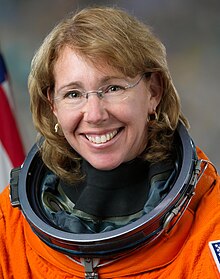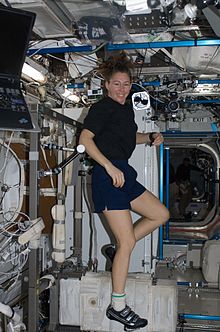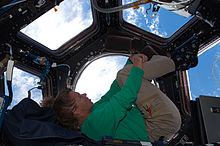Sandra Magnus
Sandra Magnus | |
|---|---|
 Magnus in 2011 | |
| Born | October 30, 1964 Belleville, Illinois,U.S. |
| Education | Missouri University of Science and Technology(BS) Georgia Institute of Technology(MS,PhD) |
| Space career | |
| NASA astronaut | |
Time in space | 157d 8h 42m[1] |
| Selection | NASA Group 16 (1996) |
| Missions | STS-112 STS-126/119(Expedition 18) STS-135 |
Mission insignia | |
| Scientific career | |
| Fields | Materials science |
| Thesis | An Investigation of the Relationship between the Thermochemistry and Emission Behavior of Thermionic Cathodes Based on the BaO-Sc₂O₃-WO₃ Ternary System(1996) |
| Doctoral advisor | Norman Hill |
| Signature | |
Sandra Hall Magnus(born October 30, 1964) is an Americanengineerand a formerNASAastronaut.[2]She flew to space three times, as mission specialist onSTS-112,as ISS crewmember duringExpedition 18and as mission specialist onSTS-135.She is also a licensedamateur radiooperator with thecall signKE5FYE. From 2012 until 2018 Magnus was the executive director of theAmerican Institute of Aeronautics and Astronautics.
Biography
[edit]Early life and education
[edit]Magnus was born and raised inBelleville, Illinois.She earned degrees inphysicsandelectrical engineeringfrom theUniversity of Missouri–Rolla(now known as the Missouri University of Science and Technology) before earning aPhDinmaterials science and engineeringfrom theGeorgia Institute of Technologyin 1996. Research for herdissertation,entitled "An Investigation of the relationship between thethermochemistryandemissionbehavior ofthermionic cathodesbased on the BaO-Sc2O3-WO3ternary system, "was supported by a fellowship from theNASA Lewis Research Center.[3]
Engineering career
[edit]During the 1980s, Magnus worked onstealth aircraftdesign as anengineerforMcDonnell Douglas.She worked on the propulsion system for theA-12 Avenger IIuntil the project was canceled by theNavyin 1991.[2]
NASA career
[edit]
Magnus was selected as an astronaut candidate in 1996. Following training for two years from January 1997 until May 1998, Magnus was assigned to the Payloads/Habitability branch in the Astronaut office. Her work included coordinating with the European Space Agency and the Development Agency of Japan (NASDA) and Brazil. In May 1998 she was assigned to work in Russia supporting payload hardware development and testing. In 2000 she wasCAPCOMfor the International Space Station.[2]
STS-112
[edit]She flew her first space mission,STS-112,in October 2002 as a mission specialist. The main objective ofSpace ShuttleAtlantis' mission was the installation of the S1 truss section on theInternational Space Station(ISS) and consumables delivery. Magnus operated the space station's robotic arm during the three spacewalks required to install and activate the S1 truss. The flight duration was 10 days 19 hours 58 minutes and 44 seconds.[1]
Survival training
[edit]From January 29–31, 2006, together with Oleg Artemiev andMichael Barratt,Magnus took part in a two-day examination for the ability to survive in an uninhabited area in case of theSoyuz descent modulemaking an emergency landing. She passed this examination in the forest nearMoscow.[4]
NEEMO 11
[edit]From September 16–22, 2006, Magnus served as the commander of NASA'sNEEMO 11mission, an undersea expedition at theNational Oceanic and Atmospheric Administration'sAquarius laboratorylocated off the coast ofFlorida.With fellow astronaut/aquanautsTimothy Kopra,Robert BehnkenandTimothy Creamer,all of whom were training for possible assignment to missions to the International Space Station, Magnus imitatedmoonwalks,tested concepts for mobility using variousspacesuitconfigurations and weights to simulate lunargravity.Techniques for communication, navigation, geological sample retrieval, construction and using remote-controlledrobotson theMoon's surface also were tested.National Undersea Research Centersupport crew members Larry Ward and Roger Garcia providedengineeringsupport inside thehabitat.[5]
Expedition 18
[edit]Magnus served as flight engineer on board the International Space Station as part ofExpedition 18.[2]Magnus was a mission specialist onSTS-126for the trip to the station, which launched on November 14, 2008. She served as mission specialist onSTS-119when it returned on March 28, 2009.[2]She logged 133 days in orbit and received warm greetings from NASA on her return. Her replacement,JAXAastronautKoichi Wakata,was launched aboardDiscoveryon March 15, 2009.[6]
STS-135
[edit]
On September 14, 2010, NASA announced Magnus to be one of four astronauts assigned to the STS-135 "launch on need" crew that was, if needed, to fly a rescue mission forSTS-134,which was originally the last scheduled shuttle flight.[7]Other members assigned to that crew were commanderChristopher Ferguson,pilotDouglas G. Hurley,and fellow mission specialistRex J. Walheim.In January 2011, NASA addedSTS-135to the manifest as the final Space Shuttle mission, scheduled to launch in July 2011; STS-134 was conducted successfully in May 2011, requiring no rescue flight. The mission launched successfully on 8 July 2011 and landed on July 21.
In September 2012, Magnus became deputyChief of the Astronaut Office.
After NASA
[edit]In October 2012, Magnus left NASA Astronaut corps to become the executive director of theAmerican Institute of Aeronautics and Astronautics(AIAA).[8]She was the executive director until January 2018.[9]
From 2018 to 2019, Magnus was a principal at AstroPlanetView. In 2019, she became the deputy director for Engineering within the Office of theUnder Secretary of Defense for Research and Engineering,[10]serving under formerNASA AdministratorMichael Griffin.
On February 9, 2021,Virgin Galacticannounced that Magnus would be joining their Space Advisory Board to help "provide advice to senior management as the company moves forward to open space for the benefit of all."[11]Magnus will be joined by former astronautChris Hadfieldand Chief Scientist ofCubic CorporationDavid A. Whelan.
References
[edit]![]() This article incorporatespublic domain materialfrom websites or documents of theNational Aeronautics and Space Administration.
This article incorporatespublic domain materialfrom websites or documents of theNational Aeronautics and Space Administration.
- ^abBecker, Joachim."Astronauts and Cosmonauts (sorted by" Time in Sace ")".spacefacts.de.
- ^abcde"Sandra H. Magnus (Ph.D.) NASA Astronaut"(PDF).NASA.NASA. October 2012.RetrievedJanuary 29,2019.
- ^Magnus, Sandra (May 1996)."An Investigation of the relationship between the thermochemistry and emission behavior of thermionic cathodes based on the BaO-Sc2O3-WO3ternary system ".SMARTech.Georgia Institute of Technology.Retrieved2008-11-16.
- ^"Future cosmonauts learn to survive in freezing weather in the Moscow forests".RuSpace. January 27, 2006.RetrievedApril 30,2011.
- ^"NEEMO 11".NASA. September 2006.RetrievedJanuary 29,2019.
- ^"Shuttle lands in Florida, ending 13-day voyage".AP. 2009-03-28. Archived fromthe originalon March 31, 2009.Retrieved2009-03-28.
- ^NASA (September 14, 2010)."NASA Assigns Crew for Final Launch on Need Shuttle Mission".RetrievedSeptember 14,2010.
- ^"AIAA Announces Sandra H. Magnus as Executive Director".September 19, 2012.
- ^"Dr. Sandra H. Magnus Executive Director Emeritus".AIAA. Archived fromthe originalon January 30, 2019.RetrievedJanuary 29,2019.
- ^"Sandra H. Magnus, Ph.D."U.S. Dept of Defense.Retrieved28 May2020.
- ^"Virgin Galactic Launches Space Advisory Board".Virgin Galactic.Retrieved13 February2021.
External links
[edit]- Sandy MagnusonTwitter
- "Sandra H. Magnus (Ph.D.) NASA Astronaut"(PDF).NASA.NASA. October 2012.RetrievedJanuary 29,2019.
- Spacefacts biography
- "Spacebook," Dr. Magnus's blog during her 2008-9 mission aboard the ISS
- NASA biographyOctober 2012
- 1964 births
- Living people
- Amateur radio people
- Aquanauts
- Crew members of the International Space Station
- American women astronauts
- Georgia Tech alumni
- Missouri University of Science and Technology alumni
- People from Belleville, Illinois
- American women engineers
- Amateur radio women
- Space Shuttle program astronauts
- American electrical engineers
- Engineers from Illinois
- 21st-century American women
- United States Astronaut Hall of Fame inductees
